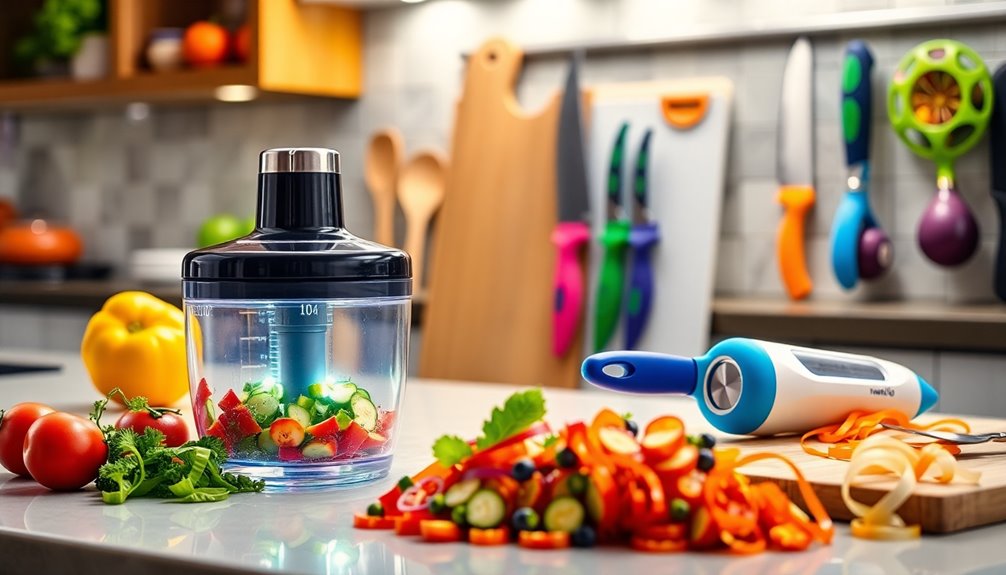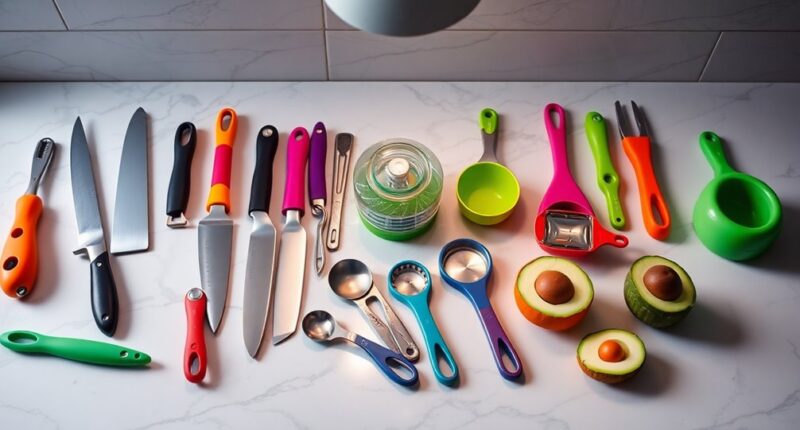If your knife skills are lacking, don’t worry! A selection of the right kitchen gadgets and tools can transform your cutting game. Investing in essential knives like a chef’s knife and paring knife is key, but specialized tools like julienne peelers and precision cut rulers can enhance your efficiency and precision. With quality tools in hand, you’ll build confidence and mastery over time. Keep exploring to discover the top 26 gadgets that can elevate your kitchen skills!
Key Takeaways
- Invest in a versatile knife set, including a chef’s knife, paring knife, and serrated knife for efficient cutting tasks.
- Utilize specialized gadgets like julienne peelers and stainless steel cut rulers to simplify cutting techniques and enhance accuracy.
- Regularly maintain knife sharpness with a high-quality honing tool and reliable knife sharpener for safer, smoother cuts.
- Employ proper grip techniques, like pinch and claw grips, to improve control and reduce the risk of injury while cutting.
- Explore online tutorials and resources to enhance your knife skills and gain confidence in the kitchen.

When you step into the kitchen, having the right tools can make mastering knife skills easier and more enjoyable. First, you’ll want to invest in essential knives like a chef’s knife, a paring knife, and a serrated knife. These will handle most cutting tasks efficiently.
Remember, treat your knife as if it’s sharp to prevent accidents. A sharp knife isn’t just safer; it also requires less pressure, allowing for smooth, precise cuts to be achieved. Additionally, using a high-quality honing tool can help maintain that sharp edge over time.
Using the right grip techniques, like the pinch grip or claw grip, enhances your control and safety while cutting. To maintain that sharpness, you’ll need a reliable knife sharpener. Keeping your knives sharp is key to efficient cutting and overall safety in the kitchen.
A sturdy cutting board is also essential; it provides a stable surface for slicing, dicing, and chopping various ingredients.
If you’re just starting out, a versatile knife set that includes a chef’s knife is recommended. For those looking to master specific cuts, consider investing in tools like stainless steel cut rulers for precision.
Don’t forget about safety gloves; while optional, they can provide extra protection as you hone your skills.
As you advance, you’ll encounter different cuts like dicing, chopping, and julienne. Online resources like YouTube tutorials or cooking blogs can offer invaluable guidance on these techniques.
Specialized tools such as julienne peelers or mandolines can make your cutting tasks easier and more efficient.
Regular knife care and maintenance are crucial, too. Clean your knives immediately after use to prevent rust and store them securely to avoid accidents.
All these gadgets and tools won’t only enhance your knife skills but also make your time in the kitchen more enjoyable. So, gear up, practice your techniques, and watch your confidence grow!
Frequently Asked Questions
What Are Some Basic Knife Skills Every Beginner Should Learn?
Every beginner should learn essential knife skills like dicing, mincing, slicing, and chopping.
Start by mastering grips like the pinch grip for better control and the claw position to protect your fingers. Regular practice will boost your confidence and speed, so don’t hesitate to try new ingredients.
Consider watching video tutorials or taking hands-on classes to see techniques in action. Remember, patience is key as you develop your knife skills over time.
How Do I Choose the Right Knife for My Cooking Needs?
Choosing the right knife is like selecting a trusty steed for a culinary adventure!
You need a blade that feels like an extension of your hand. Consider forged high-carbon stainless steel for durability and edge retention.
Look for a full-tang design for balance and control. A 7-8 inch chef’s knife is versatile enough for most tasks.
Don’t forget to factor in your comfort; a well-fitted handle is essential for effortless slicing!
Are There Any Safety Tips for Using Kitchen Knives?
Absolutely, there are several safety tips you should follow when using kitchen knives.
Always maintain sharp blades for better control, and use a stable cutting board to prevent accidents.
Keep your focus while cutting, gripping the knife handle securely.
Remember the claw position with your fingertips curled under, and carry knives with the blade pointed downward.
Lastly, clean and dry your knives right after use to keep them in top shape.
Can I Sharpen My Knives at Home, and How?
Yes, you can sharpen your knives at home! Start by choosing a method that suits you.
Whetstones offer precision, while honing rods maintain existing edges. For quick fixes, a coffee mug’s rough bottom works surprisingly well. If you prefer convenience, electric sharpeners are an option, though they may not be as effective.
Whichever method you choose, practice regularly to improve your skills and keep your knives in top shape for cooking!
What Are the Signs That My Knife Needs Sharpening or Replacing?
You’ll know your knife needs sharpening if it squashes food instead of slicing cleanly, or if you find yourself applying more pressure to cut through items.
Look for nicks, dull spots, or a matte finish on the blade. If it drags while cutting or produces inconsistent slices, it’s time to sharpen.
If you notice these signs persistently, consider replacing the knife altogether for safety and better cooking results.
Conclusion
So, whether you’re a culinary novice or just looking to up your game, these 26 kitchen gadgets and tools can transform your cooking experience. Why struggle with dull knives and clumsy cuts when you can embrace the ease of innovation? With the right tools in hand, you’ll not only save time but also impress your friends with your newfound skills. Don’t let bad knife skills hold you back—step into the kitchen with confidence and let creativity flow!









